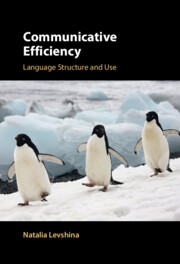Book contents
- Communicative Efficiency
- Communicative Efficiency
- Copyright page
- Dedication
- Contents
- Figures
- Tables
- Preface
- Acknowledgements
- Abbreviations
- Part I Different Types of Efficiency in Language
- Part II Efficiency and Language Evolution
- 5 Emergence of Efficient Language Patterns
- 6 From Trade-Offs to Causal Networks
- Part III Case Studies
- Appendices
- References
- Index
6 - From Trade-Offs to Causal Networks
from Part II - Efficiency and Language Evolution
Published online by Cambridge University Press: 03 November 2022
- Communicative Efficiency
- Communicative Efficiency
- Copyright page
- Dedication
- Contents
- Figures
- Tables
- Preface
- Acknowledgements
- Abbreviations
- Part I Different Types of Efficiency in Language
- Part II Efficiency and Language Evolution
- 5 Emergence of Efficient Language Patterns
- 6 From Trade-Offs to Causal Networks
- Part III Case Studies
- Appendices
- References
- Index
Summary
The notion of efficient trade-offs is popular in studies of language from an efficiency perspective. These studies represent a valuable contribution to functional approaches to language. They provide interesting hypotheses for large-scale empirical investigations. At the same time, trade-offs can turn out to be oversimplifications when we focus only on correlations between two variables. The next step is to investigate causal (directional) networks with multiple factors that can influence language use and structure. A first attempt is shown in the case study of Subject and Object cues. We find that the correlation between word order freedom and case marking is robust and cannot be reduced to the effect of other linguistic cues. Also, the causal analyses suggest that the causal direction is more likely to be from word order to case marking than the other way round. At the same time, the evidence makes us conclude that the way efficiency is reflected in aggregate linguistic variables is anything but straightforward.
Keywords
- Type
- Chapter
- Information
- Communicative EfficiencyLanguage Structure and Use, pp. 136 - 152Publisher: Cambridge University PressPrint publication year: 2022



